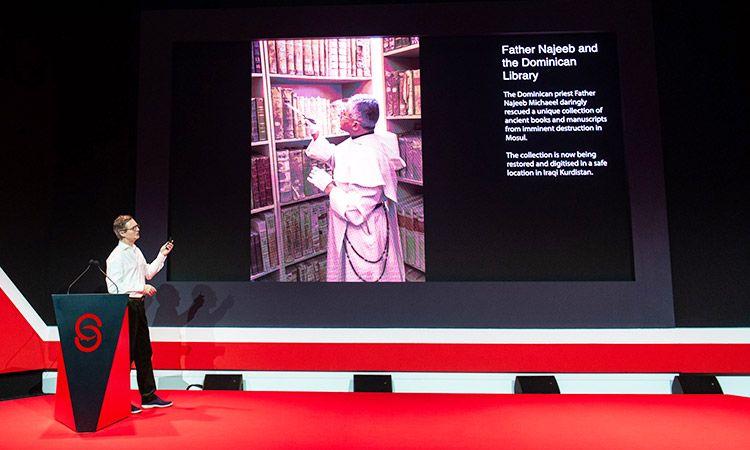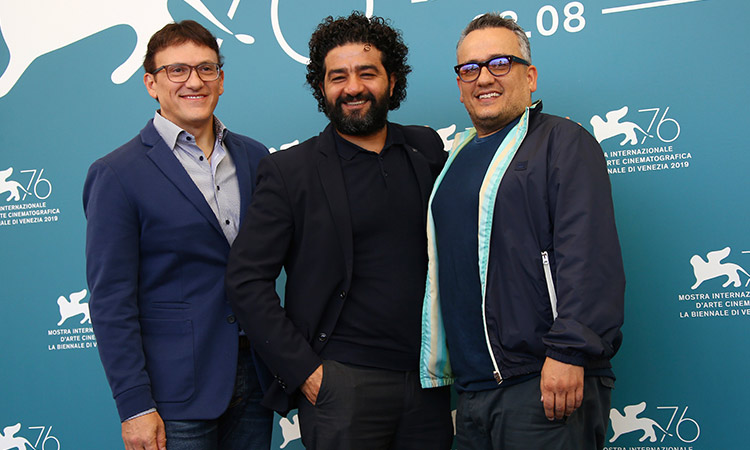Cultural heritage of Middle East rivets British filmmaker

Wilding also talked about Iraqi friar Father Najeeb’s brave efforts to rescue the Holy Books from falling into the hands of Daesh extremists.
Gulf Today, Staff Reporter
London-based curator, photographer and filmmaker Richard Wilding took a fascinated audience on a visual odyssey across the Middle Eastern regions of Iraq, Syria and Saudi Arabia in his talk “Endangered Heritage of the Middle East” on Monday, March 4, at the Xposure International Photography Festival in Sharjah.
The cultural and historical wealth of Iraq and North-East Syria, their destruction under Daesh, and the present restoration activities were discussed through slideshows; the recognition and revival of Saudi Arabia’s heritage areas and its colourful costumes and living spaces were a discovery for the viewers. Since 2010, Wilding has worked on projects that aim to preserve the vulnerable heritage in diverse regions of Asia and North Africa including Saudi Arabia, Kurdistan, Iraq, Syria, Egypt and Afghanistan.
Wilding began his visual tour with the Erbil citadel in Iraq, one of the world’s longest continuously inhabited cities that is fragile and depopulated now; Amadiya, another city on top of natural cliffs; the Yezidi shrine of Sheikh Adi in Lalish, its olive oil jars and colourful pieces of cloth with knots that represent people’s wishes, and two Yezidi tombs in the valley.
The tomb of Prophet Nahum in Alqosh; Father Najeeb and how he saved the Holy Books of the Dominican Library from the Daesh; the historical Great Al Nuri Mosque in Mosul with its leaning minaret where Abubakr al-Baghdadi, the Daesh chief, gave his first speech; and the mosque of Prophet Yunus (Jonah) in Nineveh destroyed by Daesh were also part of his visual tour. Wilding juxtaposed his images with those taken by British photographer Anthony Kersting in the 1940s to impress upon the audience the extent of destruction over the years.
Wilding then moved to illustrate through his photography the northeast Syria, the epicentre of destruction, and his work through ‘Eye on Heritage’ – a platform he co-founded to help local filmmakers in Syria and Afghanistan promote their music, poetry and storytelling traditions to international audiences.
In Saudi Arabia, Wilding stressed that he has been working with the ‘Mansoojat Foundation’ to preserve the kingdom's traditional costumes and artisanal crafts. As a trustee of the Mansoojat Foundation, he contributed to the book Traditional Costumes of Saudi Arabia which brings to life a colourful and rich tradition that was earlier obscured by an ill-informed image of the country.
Over 13 years, he had extensively researched and documented traditional costumes, crafts, archaeology, and architecture in Saudi Arabia. Wilding showed the colourful costumes, head dresses, jewellery and houses of various mountain tribes – Jahdaly, Bani Malik, Asir, Jazan etc – and how the changed social environment in the kingdom has led to a revival of the heritage and crafts.
Starting an expedition to various parts of the kingdom in 2010, Wilding had come across the pristine oasis of Al Ula on the Yemeni border which is now being promoted by the Saudi government as a nature tourism destination.
Wilding also presented the handmade beads of the Bani Sa’ad tribe and the elaborate costumes that gave its women financial security; the flower men of Al Bahah with their floral headgears; and monumental rock-cut tombs in Hegra that are remnants of the Nabatean civilisation.
While acknowledging that unbridled tourism can spoil the magical beauty of Hegra like it has done to Jordan’s Petra, another Nabatean landmark, he said the positive side to the story is that it will support the crafts and help the local people make a living. “Heritage has a positive impact on communities,” he concluded.
The 8th and biggest edition of Xposure, happening in Expo Centre Sharjah, came to a close on March 5.







